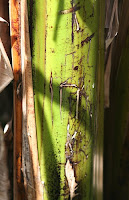Bananas have been in our diet for many years and there are references going back to around 500BC.
100 billion bananas are eating around the world and 51% of these
are eaten at breakfast. Bananas are the
most popular fruit in the world. Some
horticulturists believe that the banana was the first fruit on earth. There are 1000 different varieties of banana
growing around the world which is subdivided into 50 groups. The Cavendish banana is the most common
banana that is exported worldwide.
 |
| leaves of banana plant |
The banana plant is a large perennial herb with leaf sheaths
that form trunk-like pseudostems. The
plant has 8 to 12 leaves that can grow to 9 feet long 2 feet wide.
 |
| root system of banana plant |
The development of roots in loose soil can be
up to 30 feet laterally.
 |
| pseudostem |
The pseudostems is the part of the banana plant that looks
like a trunk. It is formed by the tightly packed overlapping leaf sheaths. . Each
pseudostem produces only one banana cluster before dying. New stalks are produced from the rhizome so
the plants will continue to make more bananas for several years.
 |
| rhizome |
Rhizome, horizontal
underground plant stem that is capable of producing the shoot and root systems
of a new plant. Rhizomes store starches and proteins and enable plants to
survive underground during unfavourable seasons.
 |
| the inflorescence |
The Flower first appears on the mother tree, the first tree roughly 9 to 12 months after first planting.
 The inflorescence (flower stalk)
grows through the centre of the pseudostems. Flowers develop in clusters and
spiral around the main axis. In most cultivars, the female flowers are followed
by a few "hands" of neuter flowers that have aborted ovaries and
stamens. The neuter flowers are followed at the terminal ends by male flowers
enclosed in bracts. The male flowers have functional stamens but aborted
ovaries.
The inflorescence (flower stalk)
grows through the centre of the pseudostems. Flowers develop in clusters and
spiral around the main axis. In most cultivars, the female flowers are followed
by a few "hands" of neuter flowers that have aborted ovaries and
stamens. The neuter flowers are followed at the terminal ends by male flowers
enclosed in bracts. The male flowers have functional stamens but aborted
ovaries.Fruits mature in about 60 - 90 days after flowers first appear. Each bunch of fruits consists of variable numbers of "hands" along a central stem. Each "hand" consists of two transverse rows of fruits ("fingers").

The fruit quality is determined by size (finger length and thickness), evenness of ripening, freedom from blemishes and defects, and the arrangement of the clusters.
Mature bananas are 2.5 to 12
inches in length and 0.75 to inches in width.
Banana peels can be red, yellow, or green or another colour depending on
the type of banana plan. The flesh of
the banana can be white to yellow in colour.
The texture of the banana is firm and gradually turns tenderer as it
ripens.
The yellow banana is called Cavendish banana and originated from China and Vietnam. This banana was named after the man who obtained the specimen of this plant., the sixth Duke of Devonshire, William Cavendish. Other names for this banana is canary banana and Chinese banana.

Red bananas are smaller in size than a common banana and the peel is a deep red or purple. It has a creamy white to pink flesh, with a slight raspberry-banana flavour. The overall taste is similar to a common yellow banana. They are imported from Costa Rica and are a favourite in Central America.

Red bananas are smaller in size than a common banana and the peel is a deep red or purple. It has a creamy white to pink flesh, with a slight raspberry-banana flavour. The overall taste is similar to a common yellow banana. They are imported from Costa Rica and are a favourite in Central America.
Blue
Java Banana are blue in colour. They have large burgundy flowers that
make the trio of colours.
Its a beautiful tree and must be seen to believe.
Pink velvet bananas measure 3 inches long and they have seeds. The plant grows 6 feet in height and flowers just after a year. This banana is eatable. The banana is sweet tasting. When the banana is ripe it peels itself.

The purple banana plant is an ornamental plant.
Some Interesting facts about bananas
- The scientific name for banana is 'musa sapientum' which translates as 'fruit of the wise man'
- The word banana comes from the Arabic word "banan", meaning finger
- The banana plant is not a tree, it is the world's largest herb
- The "trunk" of a banana plant is not made of wood, it is made of tightly overlapping leaves
- Bananas could help you to feel happier, as they contain tryptophan, a type of protein that the body converts into serotonin, known to promote relaxation and improve mood
- The inside of a banana skin can be used to calm an itchy mosquito bite - many people find that rubbing the bite with the skin helps to reduce irritation
- A medium-sized banana contains only 95 calories, and provides a quick-but-sustained energy boost in a natural, nutritious and easily digestible form with no fat, cholesterol or sodium
- British Banana supplier, Fyffes, received its first consignment of bananas 124 years ago, in September 1888
- A stem of bananas consists of “hands”, which consist of 10 to 20 bananas. When a hand is split, the bananas become “clusters”, which generally consist of between three to eight bananas
- The inside of a banana skin can be used to polish shoes!





No comments:
Post a Comment